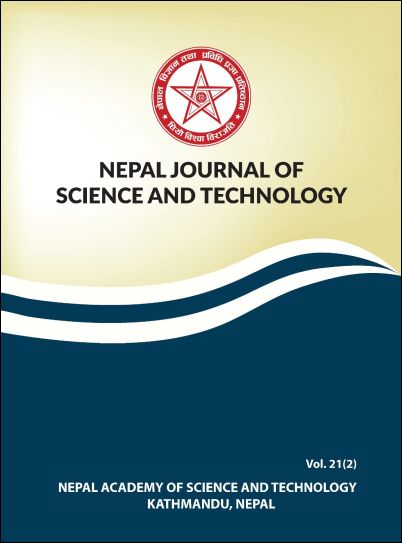Recent Trends of Mean Maximum and Minimum Air Temperatures in Bangladesh
DOI:
https://doi.org/10.3126/njst.v21i2.62356Keywords:
Mann–Kendall test, Sen’s slope estimator, Linear regression, TemperatureAbstract
The annual, seasonal, and monthly maximum and minimum air temperature time series for 34 stations in Bangladesh have been examined during the period 1981– 2020 in this study. Three statistical tests were used in the analysis namely Mann–Kendall, Sen’s slope estimator, and linear regression, respectively. 47% of stations experienced significantly rising maximum air temperature trends during the pre-monsoon, 100% during the monsoon, 74% during the post-monsoon, and 24% during the winter season, respectively. Similar findings have been made about minimum air temperatures during the pre-monsoon, monsoon, post-monsoon, and winter seasons in 41, 91, 41, and 35% of stations over Bangladesh. According to the linear regression technique, the significant increasing trends of the maximum air temperatures at Patuakhali and Mongla stations are 0.83°C/decade and 0.82°C/decade in February and October, respectively. Furthermore, at Sandwip and M. Court, the significant increasing minimum air temperature trends in July and March are 0.26°C/decade and 0.66°C/decade, respectively. The highest monthly maximum and minimum air temperature time series value falls (decreases) were seen in January over the stations at Mongla (-0.58°C/decade) and Sandwip (-0.63°C/decade), respectively. This information will be useful in developing adaptation plans to mitigate the harmful effects of climate change. Vulnerability assessments, disaster management, enhanced structure design, institutional reform, and antiextreme climate engineering are some of the viable climate change adaptation approaches in Bangladesh due to rising temperatures.
Downloads
Downloads
Published
How to Cite
Issue
Section
License
Copyright (c) 2022 The Author(s)

This work is licensed under a Creative Commons Attribution-NonCommercial 4.0 International License.
Authors retain copyright and grant the journal right of first publication.




